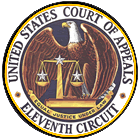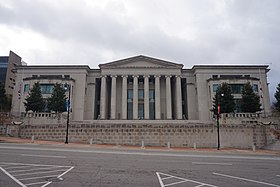Beverly Howard may refer to:

The United States District Court for the Middle District of Alabama is a federal court in the Eleventh Circuit.
Van Orden v. Perry, 545 U.S. 677 (2005), was a United States Supreme Court case involving whether a display of the Ten Commandments on a monument given to the government at the Texas State Capitol in Austin violated the Establishment Clause of the First Amendment.

John Malcolm Patterson is an American politician who has served one term as the 44th Governor of the U.S. state of Alabama from 1959 to 1963. A staunch segregationist, he was his state's attorney general from 1955 to 1959. His turbulent tenure as governor was roiled by numerous civil rights protests and a long-running extramarital affair with Tina Sawyer, a mother-of-two who would eventually become his third wife.
Charles Allen Graddick Sr., was the 42nd Attorney General of Alabama from 1979-1987. He later served as a Judge of the 13th Judicial Circuit Court of the U.S. state of Alabama.

William Holcombe Pryor Jr. is a United States Circuit Judge of the United States Court of Appeals for the Eleventh Circuit and a Commissioner of the United States Sentencing Commission. Previously, he was the Attorney General of Alabama, from 1997 to 2004.

The Alabama State Capitol, listed on the National Register of Historic Places as the First Confederate Capitol, is the state capitol building for Alabama located on Capitol Hill, originally Goat Hill, in Montgomery that was declared a National Historic Landmark on December 19, 1960.

Glassroth v. Moore, CV-01-T-1268-N, and its companion case Maddox and Howard v. Moore, CV-01-T-1269-N, 229 F. Supp. 2d 1290, affirmed, 335 F.3d 1282, concern then-Alabama Supreme Court Chief Justice Roy S. Moore and a stone monument of the Ten Commandments in the rotunda of the Heflin-Torbert Judicial Building in Montgomery, Alabama.

The Supreme Court of Alabama is the highest court in the state of Alabama. The court consists of a Chief Justice and eight Associate Justices. Each justice is elected in partisan elections for staggered six-year terms. The Supreme Court is housed in the Heflin-Torbert Judicial Building in downtown Montgomery, Alabama.
Drayton Nabers Jr. is an American lawyer and former Chief Justice of the Alabama Supreme Court. He was appointed to the court in 2003 by Governor Bob Riley following Chief Justice Roy Moore's removal as a result of his refusal to remove his Ten Commandments Monument from the State Judicial Building despite a federal court order to do so, an event that attracted national media attention.

Roy Stewart Moore is an American politician who served as the 27th and 31st chief justice of the Supreme Court of Alabama and was each time removed from that office. He was the Republican nominee in the 2017 United States Senate special election in Alabama to fill the seat vacated by Jeff Sessions, but lost to Democratic candidate Doug Jones. Moore ran unsuccessfully for the United States Senate in 2020.

Sue Bell Cobb is an American jurist and former Chief Justice of the Alabama Supreme Court, the first woman to hold that office in Alabama's history. In 2018 she unsuccessfully ran for governor of Alabama losing in the primary to Tuscaloosa mayor Walt Maddox only receiving 30 percent of the vote compared to his 52 percent.

Perry Oliver Hooper Sr. was an American jurist who served as the twenty-seventh Chief Justice of the Alabama Supreme Court from 1995 to 2001. He was the first Republican since Reconstruction to have been elected to his state's highest court.
Pleasant Grove City v. Summum, 555 U.S. 460 (2009), is a United States legal case relating to the Constitution's prohibition on a government establishment of religion specifically with respect to monuments on public land.
The Foundation for Moral Law is a socially conservative, Christian right legal advocacy group based in Montgomery, Alabama.
Tom Parker is an American lawyer and judge. He is the Chief Justice of the Alabama Supreme Court winning election in November, 2018. He previously served as an Associate Justice on the court having been elected to that position in 2004 and re-elected in 2010.

Robert Smith Vance Jr. is an American lawyer and jurist who is a circuit court judge on Alabama's 10th Judicial Circuit, located in Birmingham, Alabama.
The Ten Commandments Monument, authorized by the Oklahoma legislature and approved by the governor in 2009, was installed on the grounds of the Oklahoma State Capitol, in Oklahoma City, in 2012. The mere concept engendered years of political controversy, court suits based on religious freedom of religion issues, destruction in 2014 by a man who drove his car into it, replacement in the same location, and even attempts to remove Supreme Court justices who ruled in 2014 that the monument must be removed to another site. After Governor Mary Fallin, key legislators, and the justices agreed on a substitute site, the monument was removed from the capitol grounds in 2015.
Ten Commandments Monument may refer to:











